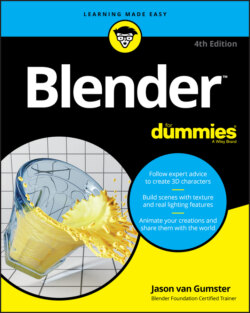Читать книгу Blender For Dummies - Jason van Gumster - Страница 34
Orbiting, panning, and zooming the 3D Viewport
ОглавлениеWhen trying to navigate a three-dimensional space through a two-dimensional screen like a computer monitor, you can’t interact with that virtual 3D space exactly like you would in the real world, or as I like to call it, meatspace. The best way to visualize working in 3D through a program like Blender is to imagine the 3D Viewport as your eyes to this 3D world. But rather than thinking of yourself as moving through this environment, imagine that you have the ability to move this entire world around in front of you.
The most basic way of navigating this space is called orbiting. Orbiting is the rough equivalent of rotating the 3D world around a fixed point in space. In order to orbit in Blender, middle-click anywhere in the 3D Viewport and drag your mouse cursor around.
Occasionally, you have the need to keep your orientation to the world, but you’ll want to move it around so that you can see a different part of the scene from the same angle. In Blender, this movement is called panning, and you do it by holding Shift while middle-clicking and dragging your mouse cursor in the 3D Viewport. Now when you drag your mouse cursor around, the world shifts around without changing the angle that you’re viewing from.
The third way of navigating 3D space is when you want to get closer to an object in your scene. Similar to working with a camera, this movement is called zooming the view. In Blender, you can zoom in two ways. The easiest method is by using your mouse’s scroll wheel. By default, scrolling forward zooms in and scrolling back zooms out. However, this method doesn’t always give you fine-grained control, and, even worse, some people don’t have a mouse with a scroll wheel. In these cases, you can zoom by holding Ctrl while middle-clicking in the 3D Viewport. Now, when you drag your mouse cursor up, you zoom in, and when you drag your mouse cursor down, you zoom out. If you prefer to move your mouse horizontally rather than vertically for zooming, you can adjust this behavior in the Navigation section of Preferences.
For the pedantic among us, you may notice that this use of the word “pan” isn’t an accurate reflection of what panning is in meatspace. When working with a traditional film or video camera, panning is the act of horizontally rotating the camera, like when capturing a panorama (the origin of the word pan). Unfortunately, this word has been re-appropriated in computer graphics to generically mean moving along a plane in 3D space. Likewise, zooming in Blender isn’t exactly like zooming in a real camera; it’s more like moving the whole camera closer or farther away from the subject. It makes me sad, but that’s just the way things are.
If you happen to be working with a mouse that doesn’t have a middle mouse button or you work with a pen and tablet interface, you should go to Preferences under Input and enable the Emulate 3 Button Mouse check box. With this check box enabled, you can emulate the middle mouse button by pressing Alt+left-click. So orbiting is Alt+left-click, panning is Shift+Alt+left-click, and zooming is done with Ctrl+Alt+left-click. Table 2-1 has a more organized way of showing these hotkeys.
TABLE 2-1 Keyboard/Mouse Keys for Navigating 3D Space
| Navigation | Three-Button Mouse | Emulated 3-Button Mouse |
| Orbit | Middle-click | Alt+left-click |
| Pan | Shift+middle-click | Shift+Alt+left-click |
| Zoom | Ctrl+middle-click | Ctrl+Alt+left-click |
Introduced with Blender 2.80, there are now some additional navigation controls in the upper right corner of the 3D Viewport. You can see them in Figure 2-2 as the four icons and mini navigation axes. These controls are particularly helpful when working in Blender with a drawing tablet, but they’re also handy if you just don’t want to use the keyboard as much while working. The following list describes how each control works:
Navigation mini-axes: This unique widget not only shows you the orientation from which you’re viewing your 3D scene, but it also gives you immediate control over orbiting the view. Click and drag on these colored axes to orbit your view just like you would by middle-clicking. As an additional bonus feature, if you click any of the circles at the extent of any of these axes, Blender automatically gives you a view of your scene as if looking down that axis. This method is a very quick way of seeing the front, side, and top views of an object you’re making.
Zoom control: Click and drag this icon to zoom in and out of your scene. Just like Ctrl+middle-clicking, move your mouse cursor up to zoom in and down to zoom out.
Pan control: Click and drag this icon to pan the view. This is the same as Shift+middle-clicking and dragging anywhere in the 3D Viewport.
Camera view toggle: Click the camera icon to toggle between your normal user view of the 3D scene and the view from the perspective of your camera object.FIGURE 2-2: Navigation controls at the top right of the 3D Viewport give you fast mouse-based control over how you see your 3D scene.
Perspective/Orthographic projection toggle: Click this icon to switch between perspective and orthographic views. The orthographic view of a 3D scene is similar to how technical drawings and blueprints are done. If two objects are the same size, they always appear to be the same size, regardless of how far away from you they are. This view is ideal for getting sizes and proportions correct in your models, especially if they’re based on blueprints or technical drawings. The perspective view is more akin to how you actually see things. That is, objects in the distance look smaller than objects that are near you.
